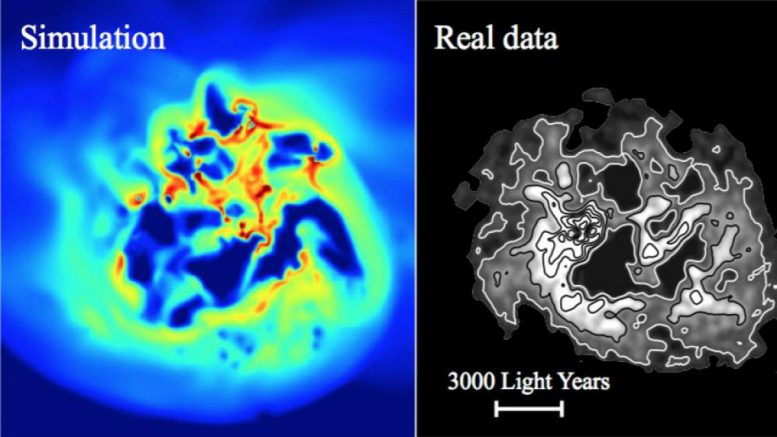
Star formation in tiny dwarf galaxies can slowly “heat up” the dark matter, pushing it outwards. The left image shows the hydrogen gas density of a simulated dwarf galaxy, viewed from above. The right image shows the same for a real dwarf galaxy, IC 1613. In the simulation, repeated gas inflow and outflow causes the gravitational field strength at the center of the dwarf to fluctuate. The dark matter responds to this by migrating out from the center of the galaxy, an effect known as ‘dark matter heating’.
Scientists have found evidence that dark matter can be heated up and moved around, as a result of star formation in galaxies. The findings provide the first observational evidence for the effect known as ‘dark matter heating’, and give new clues as to what makes up dark matter. The research is published today in the journal Monthly Notices of the Royal Astronomical Society.
In the new work, scientists from the University of Surrey, Carnegie Mellon University, and ETH Zürich set out to hunt for evidence of dark matter at the centers of nearby dwarf galaxies. Dwarf galaxies are small, faint galaxies that are typically found orbiting larger galaxies like our own Milky Way. They may hold clues that could help us to better understand the nature of dark matter.
Dark matter is thought to make up most of the mass of the universe. However since it doesn’t interact with light in the same way as normal matter, it can only be observed through its gravitational effects. The key to studying it may however lie in how stars are formed in these galaxies.
When stars form, strong winds can push gas and dust away from the heart of the galaxy. As a result, the galaxy’s center has less mass, which affects how much gravity is felt by the remaining dark matter. With less gravitational attraction, the dark matter gains energy and migrates away from the center, an effect called ‘dark matter heating’.
The team of astrophysicists measured the amount of dark matter at the centers of 16 dwarf galaxies with very different star formation histories. They found that galaxies that stopped forming stars long ago had higher dark matter densities at their centers than those that are still forming stars today. This supports the theory that the older galaxies had less dark matter heating.
Professor Justin Read, lead author of the study and Head of the Department of Physics at the University of Surrey, said: “We found a truly remarkable relationship between the amount of dark matter at the centers of these tiny dwarfs, and the amount of star formation they have experienced over their lives. The dark matter at the centers of the star-forming dwarfs appears to have been ‘heated up’ and pushed out.”
The findings provide a new constraint on dark matter models: dark matter must be able to form dwarf galaxies that exhibit a range of central densities, and those densities must relate to the amount of star formation.
Professor Matthew Walker, a co-author from Carnegie Mellon University, added: “This study may be the “smoking gun” evidence that takes us a step closer to understanding what dark matter is. Our finding that it can be heated up and moved around helps to motivate searches for a dark matter particle.”
The team hopes to expand on this work by measuring the central dark matter density in a larger sample of dwarfs, pushing to even fainter galaxies, and testing a wider range of dark matter models.
Publication: “Dark matter heats up in dwarf galaxies” by J I Read, M G Walker and P Steger, 3 January 2019, MNRAS.
DOI: 10.1093/mnras/sty3404









The accretion theory of how stars and planets formed makes no sense.. a gas will always try and reach equilibrium of pressure and the weak force of gravity could not overcome this.. if you put a bunch of gas into the vacuum of space it will disperse, not come together because of it’s miniscule gravity..
first of all the premise of dark matter is an absurd theory as if it was something different. Of course there is a great deal of matter in the universe besides that matter that emits large quantities of light on a ratio 8 to one if our planetary system might be a guide. The moon is dark matter and it does’t take a Phd to develope some “unique sounding theory” Indeed the assumption that we are apply to see all the self lighted matter in the universe is an unsupported assumption. If nothing else there is no reason to not believe that such is the case on the other side of our own galaxy. Scientist we are not the center of the galaxy as you said for 1500 years that all the stars rotated around the piddly earth. What you think you see has nothing to do with what is actually out there many light years away. that’s what illusions are made of. I want or need something and therefore it must be what I want or see.
You’re not wrong, but you’re not entirely right either.
What you’re describing is called MACHOs (massive compact halo objects), and they’re basically big rocks that are floating out there, too far away from the illumination of a star for us to see them.
There are projects actively looking for MACHOs, using techniques like stellar occultation or gravitational microlensing, but what they’ve found so far is not nearly enough to account for the “extra” mass we detect in these galaxies.
I would love to know how they are measuring dark matter in the dwarf galaxy, this seems to be the obvious missing link in this story.
‘Pushed out’ dark matter is curved spacetime.
Dark matter is a supersolid that fills ’empty’ space, strongly interacts with ordinary matter and is displaced by ordinary matter. What is referred to geometrically as curved spacetime physically exists in nature as the state of displacement of the supersolid dark matter. The state of displacement of the supersolid dark matter is gravity.
The supersolid dark matter displaced by a galaxy pushes back, causing the stars in the outer arms of the galaxy to orbit the galactic center at the rate in which they do.
Displaced supersolid dark matter is curved spacetime.
This is good data and it indicates we have absolutely no idea what dark matter is and probably should not call it some specific, i.e. something not specific like “Effect X”.
Super symmetry demands every particle has an anti-particle, and that would tend to indicate the same should be true for the High Boson “God particle”. There is where your dark matter lies…. in the anti-particles. Can’t be seen, can’t be directly measured, because they are opposite their counterparts in every respect including measurability and recognizability.. It’s a theory anyways..
How are they ditinctly different, the composition of Dark Matter, the composition of Black Holes, potential changes in time with Dark Matter?
http://www.ldolphin.org/graps.html
I like dark matter; what I don’t like is law of conservation of energy theory…
1:18:43
No Dark Matter? – Documentary 2018 HD
Jordan B. Peterson | Full interview | SVT/TV 2/Skavlan
Why does this guy correct everybody?
https://www.youtube.com/watch?v=_iudkPi4_sY